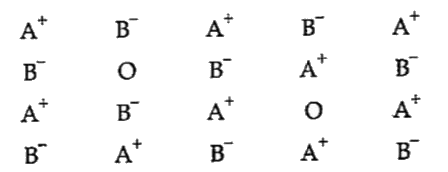Stoichiometric defect is also known as
Intrinsic defect
Impurity defect
Thermodynamic defect
Both (1) & (3)
The correct Answer is:D
Step-by-Step Solution:
1. Definition of Stoichiometric Defect:
- A stoichiometric defect is a type of defect in a solid where the overall composition of the material remains unchanged. This means that the ratio of the different types of atoms in the crystal lattice does not alter, even though some atoms may be missing or displaced.
2. Types of Defects:
- Defects in solids can be categorized into two main types: intrinsic (or stoichiometric) defects and extrinsic defects.
- Intrinsic defects occur naturally due to the structure of the material itself, while extrinsic defects arise from the introduction of impurities or foreign atoms.
3. Characteristics of Stoichiometric Defects:
- Stoichiometric defects are also referred to as intrinsic defects because they maintain the stoichiometry of the compound.
- These defects can occur due to thermal agitation, where atoms are displaced from their lattice positions, often as a result of heating.
4. Relation to Thermodynamic Defects:
- Stoichiometric defects can also be classified as thermodynamic defects because they are influenced by temperature changes. Higher temperatures can lead to increased atomic vibrations, resulting in the displacement of atoms.
5. Conclusion:
- Therefore, stoichiometric defects are also known as intrinsic defects and thermodynamic defects. The correct answer to the question is that stoichiometric defects are known as both intrinsic defects and thermodynamic defects.
Final Answer:
Stoichiometric defect is also known as intrinsic defect and thermodynamic defect.
---
- A stoichiometric defect is a type of defect in a solid where the overall composition of the material remains unchanged. This means that the ratio of the different types of atoms in the crystal lattice does not alter, even though some atoms may be missing or displaced.
- Defects in solids can be categorized into two main types: intrinsic (or stoichiometric) defects and extrinsic defects.
- Intrinsic defects occur naturally due to the structure of the material itself, while extrinsic defects arise from the introduction of impurities or foreign atoms.
- Stoichiometric defects are also referred to as intrinsic defects because they maintain the stoichiometry of the compound.
- These defects can occur due to thermal agitation, where atoms are displaced from their lattice positions, often as a result of heating.
- Stoichiometric defects can also be classified as thermodynamic defects because they are influenced by temperature changes. Higher temperatures can lead to increased atomic vibrations, resulting in the displacement of atoms.
- Therefore, stoichiometric defects are also known as intrinsic defects and thermodynamic defects. The correct answer to the question is that stoichiometric defects are known as both intrinsic defects and thermodynamic defects.
Stoichiometric defect is also known as intrinsic defect and thermodynamic defect.
Topper's Solved these Questions
- THE SOLID STATE BOOK - AAKASH INSTITUTE ENGLISHCHAPTER - THE SOLID STATE EXERCISE - Assignment (SECTION - A) (OBJECTIVE TYPE QUESTION)
58 Videos
- THE SOLID STATE BOOK - AAKASH INSTITUTE ENGLISHCHAPTER - THE SOLID STATE EXERCISE - Assignment (SECTION - B) (OBJECTIVE TYPE QUESTION)
25 Videos
- THE SOLID STATE BOOK - AAKASH INSTITUTE ENGLISHCHAPTER - THE SOLID STATE EXERCISE - ASSIGNMENT SECTION-J (AAKASH CHALLENGERS )
10 Videos
- THE S-BLOCK ELEMENTSBOOK - AAKASH INSTITUTE ENGLISHCHAPTER - THE S-BLOCK ELEMENTSEXERCISE - Assignment (Section-J)
10 Videos
- THERMODYNAMICSBOOK - AAKASH INSTITUTE ENGLISHCHAPTER - THERMODYNAMICSEXERCISE - ASSIGNMENT (Section -D) Assertion-Reason Type Questions
15 Videos
Similar Questions
Knowledge Check
Examine the given defected crystal

Answer the following questions:
What type of stoichiometric defect is shown in the crystal ?ASchottky defect, decreases, NaCl and KCl etcBFrenkel defect, increases, As and Si etcCSchottky defect, increases, As and Bi etcDFrenkel defect, decreases, NaCl, KCl etcSarus is also known as
ACraneBSpot billCPloversDFlamingoes
What type of stoichiometric defect is shown by:
(a) ZnS (b) AgBr
View SolutionPhenol is also known as
View SolutionWhat type of stoichiometric defect is shown by AgCl?
View SolutionWhat type of stoichiometric defect is shown by AgCl ?
View SolutionWhat type of stoichiometric defect is shown by KCl and why ?
View SolutionExamiine the given defective crystal

(i) What type of stoichiometric defect is shown by the the crystal ?
(ii) How is the density of the crystal affected by this defect ?
(iii) What type of ionic substance show such defect ?
View Solution